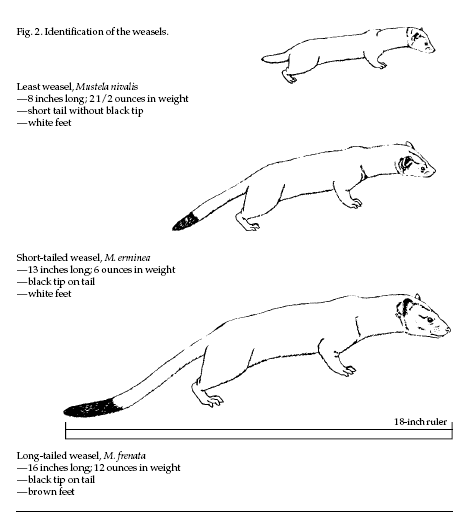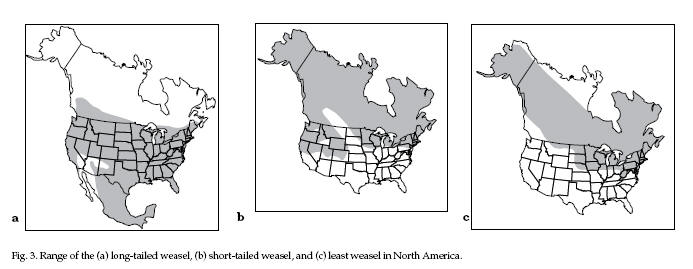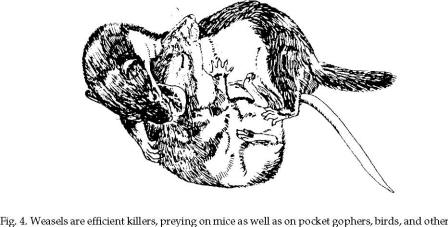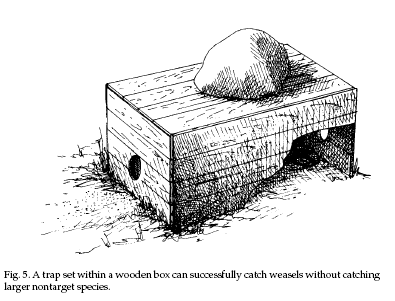|
|
|
|
 |
CARNIVORES: Weasels |
|
|

Identification
Weasels
belong to the Mustelidae family, which also includes
mink, martens, fishers, wolverines, badgers, river
otters, black-footed ferrets, and four species of
skunks. Although members of the weasel family vary in
size and color (Fig. 1), they usually have long, slender
bodies, short legs, rounded ears, and anal scent glands.
A weasel’s hind legs are barely more than half as long
as its body (base of head to base of tail). The weasel’s
forelegs also are notably short. These short legs on a
long, slender body may account for the long-tailed
weasel’s (Mustela frenata) distinctive running gait.
At every bound the long body loops upward, reminding one
of an inchworm.
In
the typical bounding gait of the weasel, the hind feet
register almost, if not exactly, in the front foot
impressions, with the right front foot and hind feet
lagging slightly behind. The stride distance normally is
about 10 inches (25 cm).
Male
weasels are distinctly larger than females. The
long-tailed and short-tailed (M. erminea) weasels have a
black tip on their tails, while the least weasel (M.
nivalis) lacks the black tip

(Fig.
2). The long-tailed weasel some-its common name implies,
the least times is as long as 24 inches (61 cm). weasel
is the smallest, measuring only The short-tailed weasel
is considerably 7 or 8 inches (18 to 20 cm) long and
smaller, rarely longer than 13 inches weighing 1 to 2
1/2 ounces (28 to 70 g). (33 cm) and usually weighing
between Many people assume the least weasel 3 and 6
ounces (87 and 168 g). Just as is a baby weasel since it
is so small.
Range
Three species of weasels live in North America. The most
abundant and widespread is the long-tailed weasel. Some
that occur in parts of Kansas, Oklahoma, Texas, and New
Mexico have a dark “mask” and are often called
bridled weasels. The short-tailed weasel occurs in
Canada, Alaska, and the northeastern, Great Lakes, and
northwestern states, while the least weasel occurs in
Canada, Alaska, and the northeastern and Great Lakes
states (Fig. 3).

Habitat
Some authors report finding weasels only in places with
abundant water, although small rodents, suitable as
food, were more abundant in surrounding habitat. Weasels
are commonly found along roadsides and around farm
buildings. The absence of water to drink is thought to
be a limiting factor (Henderson and Stardom 1983).
A
typical den has two surface openings about 2 feet (61
cm) apart over a burrow that is 3 to 10 feet (0.9 to 3
m) long. Other weasel dens have been found in the trunk
of an old uprooted oak, in a bag of feathers, in a
threshing machine, in the trunk of a hollow tree, in an
old mole run, a gopher burrow, and a prairie dog burrow
(Henderson and Stardom 1983).
 Food
Habits Food
Habits
The
weasel family belongs to the order Carnivora. With the
exception of the river otter, all members of the weasel
family feed primarily on insects and small rodents (Fig.
4). Their diet consists of whatever meat they can obtain
and may include birds and bird eggs.
As
predators, they play an important role in the ecosystem.
Predators tend to hunt the most abundant prey, turning
to another species if the numbers of the first prey
become scarce. In this way, they seldom endanger the
long-term welfare of the animal populations they prey
upon.
Long-tailed
weasels typically prey on one species that is
continually available. The size of the prey population
varies from year to year and from season to season. At
times, weasels will kill many more individuals of a prey
species than they can immediately eat. Ordinarily, they
store the surplus for future consumption, much the same
as squirrels gather and store nuts.
Pocket
gophers are the primary prey of long-tailed weasels. In
some regions these gophers are regarded as nuisances
because they eat alfalfa plants in irrigated meadows and
native plants in mountain meadows where livestock graze.
Because of its predation on pocket gophers and other
rodents, the long-tailed weasel is sometimes referred to
as the farmer’s best friend. This statement, however,
is an oversimplification of a biological relationship.
Weasels
prefer a constant supply of drinking water. The
long-tailed weasel drinks up to 0.85 fluid ounces (26
ml) daily.
General
Biology, Reproduction, and Behavior
Weasels are active
in both winter and summer; they do not hibernate.
Weasels are commonly thought to be nocturnal but
evidence indicates they are more diurnal in summer than
in winter.
Home
range sizes vary with habitat, population density,
season, sex, food availability, and species (Svendsen
1982). The least weasel has the smallest home range.
Males use 17 to 37 acres (7 to 15 ha), females 3 to 10
acres (1 to 4 ha). The short-tailed weasel is larger
than the least weasel and has a larger home range. Male
short-tailed weasels use an average of 84 acres (34 ha),
and females 18 acres (7 ha), according to snow tracking.
The
long-tailed weasel has a home range of 30 to 40 acres
(12 to 16 ha), and males have larger home ranges in
summer than do females. The weasels appear to prefer
hunting certain coverts with noticeable regularity but
rarely cruise the same area on two consecutive nights.
Weasel
population densities vary with season, food
availability, and species. In favorable habitat, maximum
densities of the least weasel may reach 65 per square
mile (169/km2); the short-tailed weasel, 21 per square
mile (54/km2); and the long-tailed weasel, 16 to 18 per
square mile (40 to 47/km2). Population densities
fluctuate considerably with year-to-year changes in
small mammal abundance, and densities differ greatly
among habitats.
Weasels,
like all mustelids, produce a pungent odor. When
irritated, they discharge the odor, which can be
detected at some distance (Jackson 1961).
Long-tailed
weasels mate in late summer, mostly from July through
August. Females are induced ovulators and will remain in
heat for several weeks if they are not bred. There is a
long delay in the implantation of the blastocyst in the
uterus, and the young are born the following spring,
after a gestation period averaging 280 days. Average
litters consist of 6 young, but litters may include up
to 9 young. The young are blind at birth and their eyes
open in about 5 weeks. They mature rapidly and at 3
months of age the females are fully grown. Young females
may become sexually mature in the summer of their birth
year.
Damage
and Damage Identification
Occasionally weasels raid
poultry houses at night and kill or injure domestic
fowl. They feed on the warm blood of victims bitten in
the head or neck. Rat predation on poultry usually
differs in that portions of the body may be eaten and
carcasses dragged into holes or concealed locations.
Legal
Status
All three weasels generally are considered
furbearers under state laws, and a season is normally
established for fur harvest. Check local and state laws
before undertaking weasel control measures.
Damage
Prevention and Control Methods
Exclusion
Weasels
can be excluded from poultry houses and other structures
by closing all openings larger than 1 inch (2.5 cm). To
block openings, use 1/2-inch (1.3-cm) hardware cloth,
similar wire mesh, or other materials.
Trapping
Weasels
are curious by nature and are rather easily trapped in
No. 0 or 1 steel leghold traps. Professional trappers in
populated areas use an inverted wooden box 1 or 2 feet
(30 or 60 cm) long, such as an apple box, with a 2-to
3-inch (5-to 8cm) round opening cut out in the lower
part of both ends (Fig. 5). Dribble a trail of oats or
other grain through the box. Mice will frequent it to
eat the grain and weasels will investigate the scent of
the mice. A trap should be set inside the box, directly
under the hole at each end of the box. Keep the trap pan
tight to prevent the mice from setting off the trap.
Alternatively,
make a hole in only one end of the box and suspend a
fresh meat bait against the opposite end of the box. Set
the trap directly under the bait.
Trap
sets in old brush piles, under outbuildings, under
fences, and along stone walls are also suggested, since
the weasel is likely to investigate any small covered
area. Trap sets should be protected by objects such as
boards or tree limbs to protect nontarget wildlife.
Weasels
can also be captured in live traps with fresh meat as
suitable bait. If trapping to alleviate damage is to be
conducted at times other than the designated season, the
local wildlife agency representative must be notified.
Economics
of Damage and Control
Svendsen (1982) writes:
“Overall,
weasels are more of an asset than a liability. They eat
quantities of rats and mice that otherwise would eat and
damage additional crops and produce. This asset is
partially counter-balanced by the fact that weasels
occasionally kill beneficial animals and game species.
The killing of domestic poultry may come only after the
rat population around the farmyard is diminished. In
fact, rats may have destroyed more poultry than the
weasel. In most cases, a farmer lives with weasels on
the farm for years without realizing that they are even
there, until they kill a chicken.”

Acknowledgments
Figures 1, 2, and 4 adapted by Jill Sack Johnson from
“Weasel Family of Alberta” (no date), Alberta Fish
and Wildlife Division, Alberta Energy and Natural
Resources, Edmonton (with permission).
Figure
3 adapted from Burt and Grossenheider (1976) by Jill
Sack Johnson.
Figure
5 adapted from a publication by the US Fish and Wildlife
Service.
For
Additional Information
Burt, W. H., and R. P. Grossenheider. 1976. A field guide to the mammals, 3d
ed. Houghton Mifflin Co., Boston. 289 pp.
Fitzgerald,
B. M. 1977. Weasel predation on a cyclic population of
the montane vole (Microtus montanus) in California. J.
An. Ecol. 46:367-397.
Glover,
F. A. 1942. A population study of weasels in
Pennsylvania. M.S. Thesis, Pennsylvania State Univ.
University Park. 210 pp.
Hall,
E. R. 1951. American weasels. Univ. Kansas Museum Nat.
Hist. Misc. PubL. 4:1-466.
Hall,
E. R. 1974. The graceful and rapacious weasel. Nat. Hist.
83(9):44-50.
Hamilton,
W. J., Jr. 1933. The weasels of New York. Am. Midl. Nat.
14:289-337.
Henderson,
F. R., and R. R. P. Stardom.1983. Short-tailed and
long-tailed weasel. Pages 134-144 in E. F. Deems, Jr.
and D. Purseley, eds. North American furbearers: a
contemporary reference. Internatl. Assoc. Fish Wildl.
Agencies Maryland Dep. Nat. Resour.
Jackson,
H. H. T. 1961. Mammals of Wisconsin. Univ. Wisconsin
Press, Madison. 504 pp.
King,
C. M. 1975. The home range of the weasel (Mustela
nivalis) in an English woodland. J. An. Ecol.
44:639-668.
MacLean,
S. F., Jr., B. M. Fitzgerald, and F. A. Pitelka. 1974.
Population cycles in arctic lemmings: winter
reproduction and predation by weasels. Arctic Alpine
Res. 6:1-12.
Polderboer,
E. B., L. W. Kuhn, and G. O. Hendrickson. 1941. Winter
and spring habits of weasels in central Iowa. J. Wildl.
Manage. 5:115-119.
Quick,
H. F. 1944. Habits and economics of New York weasel in
Michigan. J. Wildl. Manage. 8:71-78.
Quick,
H. F. 1951. Notes on the ecology of weasels in Gunnison
County, Colorado. J. Mammal. 32:28-290.
Schwartz,
C. W. and E. R. Schwartz. 1981. The Wild mammals of
Missouri, rev. ed. Univ. Missouri Press, Columbia. 356
pp.
Svendsen,
G. E. 1982. Weasels. Pages 613-628 in J. A. Chapman and
G. A. Feldhamer, eds., Wild mammals of North America:
biology, management, and economics. The Johns Hopkins
Univ. Press, Baltimore, Maryland.
Editors
Scott
E. Hygnstrom Robert M. Timm Gary E. Larson
PREVENTION
AND CONTROL OF WILDLIFE DAMAGE — 1994
Cooperative
Extension Division Institute of Agriculture and Natural
Resources University of Nebraska -Lincoln
United
States Department of Agriculture Animal and Plant Health
Inspection Service Animal Damage Control
Great
Plains Agricultural Council Wildlife Committee
01/23/2007
Special
thanks to:
Clemson University
|